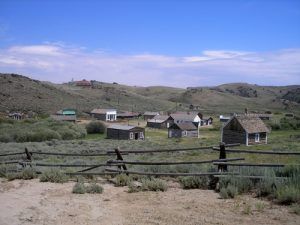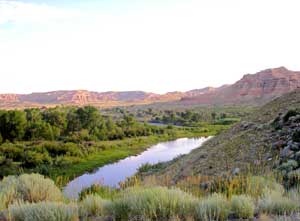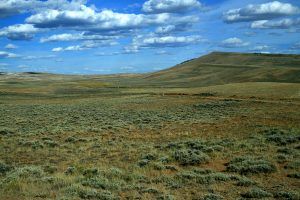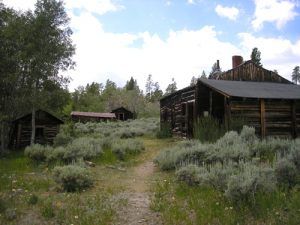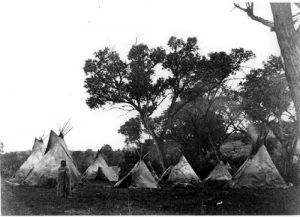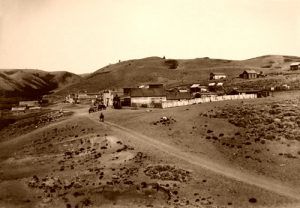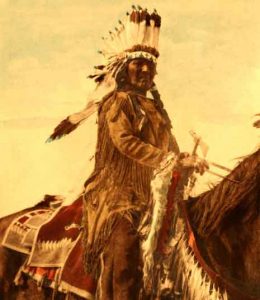Though digging for gold in the South Pass area of Wyoming began as early as 1842, mining activity was very sporadic until after the Civil War. The rich Carissa Mine was discovered in June 1867, and shortly afterward, it was attacked by Sioux Indians who killed three miners and drove the rest away. However, the trespassers would soon return along with hundreds of others as word of the gold find spread. In violation of the Fort Laramie Treaty of 1868, the miners continued to flock to the area as more gold veins were discovered and the towns of Atlantic City and Miners Delight were organized.
In May 1868, angry Indians raided the area and stole an estimated 100 horses and mules. But, this did not scare the miners away. Before long, they had replenished their animals. The following month, the warriors returned, once again stealing the stock as well as general merchandise, and killed four men. Still, the fortune-hungry prospectors stayed.
Battles:
Three Crossings (August 9, 1868) – On August 9, 1868, Indians attacked an ox train bringing supplies for one of the new mercantile establishments. At Three Crossings on the Sweetwater River, the two freighters were attacked by Indians. The wagon driver, Dave Hayes, was seriously wounded, and the other man, known as “Uncle Hirst,” was hit in the heel. Though they were both injured, they succeeded in driving off the Indians. Hayes was so seriously wounded he could not continue to travel, so Hirst made him comfortable by wrapping him in blankets under the protection of the wagon and went for help. Hirst returned with two men to rescue the wounded Dave Hayes and rescue the supplies — William Rose and William Tweed. Also going in that direction was Major Baldwin, who was going after supplies with a train of wagons.
Upon his return with William Rose, William Tweed, Major Baldwin, and a man named Leach. When they arrived at Three Crossings, they found the driver dead and the merchandise gone. Retracing their steps, they were attacked by Indians near a place called the Ice Slough. After a spirited engagement, Major Baldwin was driven back, and William Tweed and the man named Leach were wounded. Riding a fast horse, William Rose was determined to ride for help. But he wouldn’t make it. With the Indians in full pursuit, he was shot in the back of the head and fell from his saddle. However, the diversion was enough to allow the others to escape.
This attack so aroused the people in the mining district that 27 men, well mounted and armed, went in pursuit of the Indians but were unable to find them. They buried the bodies of William Rose and David Hayes and returned to the camps. Before long, they were back to looking for gold, though now, they were much better armed.
Raids on the Wind River (Spring/Summer, 1869) – The territorial government of Wyoming was organized in the spring of 1869. President Ulysses S. Grant appointed John A. Campbell as the Governor of the Wyoming Territory on April 3, 1869. Only a short time later, four white men were killed, and Sioux Indians stole several horses and mules in the Wind River Valley. The raid was reported to the governor by county commissioners, who asked the military department’s commander for troops to protect the settlers in that section. Two companies — one of infantry and one of cavalry — were ordered to the valley. With the closest military base at Fort Bridger, over 150 miles away, the U.S. Army established Camp Augur in present-day Lander in June 1869, but it wouldn’t be enough.
On July 3, 1869, another raid was made by the Sioux, and again four white men were killed. The Indians were later driven off by the new soldiers stationed in the area. Later that month, on July 28, another raid was made upon the mining settlements, and three men engaged in mining near Atlantic City were killed. At the request of Governor Campbell, the department commander sent a supply of arms and ammunition to the area to be distributed among the citizens. When the Sioux discovered that the people were being armed, they withdrew briefly.
Then on August 20, 1869, three men were traveling along the North Fork of the Big Popo Agie River. George Colt and William Skinner were killed, and William Williams was wounded. Their supplies, money, and seven horses were also stolen.
The next day, another attack was made on a party of seven men traveling along the Big Big Wind River above Bull Lake. On August 21, 1869. This party, led by Jeff Standifer, an old western explorer, prospector, and Indian fighter, left South Pass to prospect on the head of Wind River. On August 21, 1869, while in camp on Big Wind River near the mountains, they were attacked by a large party of Indians so suddenly that they could not secure their horses near the camp and had no time to defend. Hank Lehman was killed in the camp, and C.T. McAuley was killed nearby. John Moore and Mr. Duncan made their escape for a time by swimming the river but were followed for ten miles to Bull Lake, ten miles, where they were killed. Their remains were not found for some years, after which they were buried at Bull Lake. Jeff Standifer and John “Portugee” Phillips escaped into the mountains and made their way into South Pass, Standifer slightly wounded in the hand. Andy Newman, after suffering much hardship and exposure, finally made his way to the Wind River Indian Reservation, where he arrived in tatters and in deplorable condition.
The same day, the warriors encountered Henry Lusk and Sage Nickerson on Little Wind River near the Hot Springs. Immediately firing upon the men, they wounded Lusk, and his horses were taken. Nickerson attempted to save the horses belonging to Lusk, but the warriors were on him quickly. He escaped by riding rapidly to the river, into which he plunged and swam under the water to an overhanging bank, where he remained in hiding until the Indians left, taking his and the other horses with them and killing Nickerson’s dog.
Army Skirmishes (September 14-17, 1869) – On September 14, 1869, at the Shoshone reservation near the Little Wind River, a civilian named James Camp and Private John Holt of the 7th Infantry were killed. Though some said they were possibly killed by Shoshone or Bannock Indians, who shared the reservation, they were more likely killed by wandering Lakota Sioux who were known to have been in the area.
On the same day, soldiers spotted several Lakota Sioux on the Popo Agie River about three miles south of Camp Augur. Lieutenant Charles B. Stambaugh, with 28 men, rode out to investigate. After following their trail for 14 miles, Stambaugh and his men came upon about 200 Lakota Sioux and were soon in the midst of a battle. In the three-hour fight, two soldiers were wounded, eight horses killed, and four injured, so he could not pursue the retreating Lakota. Two warriors were killed, and ten more wounded. The site is located near Lander, Wyoming.
On September 17, on Twin Creek, soldiers escorting the mail were attacked and pursued into the mountains by Indians.
Miners Delight (September 29, 1869) – Near the mining camp of Miners Delight, situated just a few miles east of Atlantic City, Wyoming, a band of Sioux Indians appeared and, upon seeing John G. Anderson, who was hauling lime with three yokes of cattle, killed him and stole his cattle. The warriors then went on to Atlantic Gulch, where they found a man named Latham, who was cutting wood. They promptly killed him as well.
The band then made their way to the mouth of the Little Popo Agie River, where they encountered James Goodson, an old mountaineer that had experience with Indians. Goodson took refuge in the mouth of the canyon and warned the savages not to approach. They made signs of friendship, but Goodson was unwilling to trust them and continued waving his hand for them to keep away. The Indians began to fire on him, and though some of the shots went through his clothing, he was not hit. Goodson returned the fire and killed three of the Indians. Goodson remained in hiding until nightfall, and the warriors withdrew. He then made his way to Miners Delight.
The attacks against the miners continued the following year. On March 31, 1870, Franklin Irwin was terribly wounded and stripped of his clothes at Little Atlantic Gulch. After he walked a mile and a half to his parent’s home, his father, Dr. Irwin, tried every means to save him, but he soon died. On the same day, William S. Bennington and James Othicks were killed on Smiths Gulch, and Eugene Fosbery, John McGuire, and Anson B. Kellogg were killed at St. Mary’s Station on the Sweetwater River.
Raid on the Arapaho (April 7, 1870) – The Arapaho tribe, numbering some 400-500, on the advice of Wyoming Governor Campbell, sought permission from the Shoshone to temporarily stay on the Wind River Reservation. Arapaho Chiefs Medicine Man and Friday met with Shoshone Chief Washakie, where the Arapaho promised friendly relations with the Shoshone, as well as the white settlers and miners, and also promised to notify both of the comings of any of the northern hostiles with whom they were at peace. Chief Washakie granted permission, and the Arapaho settled on the Big Wind River about 30 miles below where the town of Lander now stands.
However, as stealing of stock and raids on white settlers continued, mostly credited to the Sioux and Cheyenne, many began to suspect that it might be the Arapaho who were conducting the depredations or, at the very least, were a part of them. When the stolen stock was found in their camp, the Arapaho claimed to have bought it from other Indians; but to those who were suspicious, this was proof that they were involved. To see if he could ascertain the facts, Captain Herman G. Nickerson of Miner’s Delight went alone as a spy to the Arapaho camp on March 31, 1870. Nickerson was well acquainted with sub-chief Friday after saving his life in the Fall of 1869. At that time, Friday was visiting the mining towns and drank too much one evening. He then got lost on the road between Atlantic City and Miner’s Delight and fell from his horse. When his mount wandered into Miners Delight, Nickerson recognized it and, backtracking, found Friday helpless on the ground and brought him back to his house. One foot was frozen, so his large toe had been amputated. Captain Nickerson provided for him until he could return to his camp on the Wind River.
When Nickerson arrived at the Arapaho camp, he found Chief Friday with a small following of some twenty lodgers about five hundred yards from the main camp of Chief Medicine Man. It was not difficult to convince Friday that he was there on a peaceful mission; however, many others did not believe him and demanded that Nickerson be killed. Friday bravely refused access to Nickerson, keeping him in his lodge away from the threatening Indians. Finally, in the wee hours of the morning, the other Arapaho left, apparently satisfied with Friday’s explanations. But, Friday was sure Nickerson would be waylaid on his way home when he left in the morning. To avoid this, Friday got him ready just before daybreak and sent a faithful brave in the opposite direction on a long detour before returning.
When Nickerson arrived back at Miners Delight, he learned of the killings that had happened the day before on the Sweetwater River. While at the Arapaho camp, he learned that a young war chief named Little Shield and several young warriors were out of camp on the Sweetwater River, allegedly on a buffalo hunt. Putting two and two together, he and others determined that the people killed on March 31 were murdered by the Arapaho, and a force of about 175 men was speedily raised. Well-armed, they reached the valley of the Big Popo Agie River. Bill Smith was chosen to lead the men because of his fearless and dare-devil disposition, although he had never been in the Arapaho camp and knew nothing about them. (He was killed a year later in Atlantic City in a street brawl.) Smith led the 75 mounted men and placed Nickerson in command of the 100 men on foot and the wagon train, with orders to follow down the river after him.
Smith and the mounted men struck out early on April 7, 1870, to eradicate the Indians. The main Arapaho camp could easily see the men approaching from a long distance in full daylight. However, along the way, Smith encountered sub-chief Black Bear, his wife, and a small band of Arapaho on their way to Camp Brown to trade. He killed Chief Black Bear, 14 grown male Indians, and two women. Two women made their escape and made their way back to the main camp to give the alarm. Seven children were captured, placed in families, and raised among the white.s
In the meantime, the main camp of the Arapaho pulled up stakes and left. When the weary footmen caught up with Smith and his group, they were encamped on the Big Wind River. With large fires blazing, the Indians could easily have returned at night and killed or driven the entire party away. However, they had already moved on. Smith’s failure as a leader caused the entire expedition to return home as a failure, and the lesson was lost. Instead of killing the Indians, which might have been done, had he approached in the night, he had succeeded only in making them more embittered and thirsty for revenge which they fully obtained in the years immediately following.
Atlantic City (May 4, 1870) – At 5:00 a.m. on May 4, 1870, Brevet Major D.S. Gordon, with his company of Second Cavalry, discovered several Indians possessing stolen stock near Atlantic City, Wyoming. Charging the warriors, they killed two Indians and wounded another before they fled. The troops recovered all of the stolen stock, which had earlier been taken from a man named Jason Wherman.
Later that same day, First Lieutenant Charles B. Stambaugh and ten men of the Second Cavalry were escorting a party of freighters along Beaver Creek near Atlantic City when attacked by a party of about 60-70 Indians. After fighting for about an hour and a half, the soldiers killed five warriors and wounded several more. However, in the battle, Lieutenant Stambaugh was shot dead from his horse, his body falling into the hands of the Indians who robbed it of a watch, ring, revolver, belt, and the contents of his pockets. They shot into his body several times, after which the company rallied and recovered the body. Another officer — Sergeant Brown, was severely wounded, having his chin and part of his jaw carried away by a bullet.
On May 29, Joseph Faris and Ed Rohm were attacked while working on the road in Red Canyon. However, this time the warriors had met their match. The two men not only stood them off and saved their horses but wounded and probably killed one of the Indians. A little deeper in the canyon, the warriors attacked a prospector named Thomas Anton. However, when the miner saw them coming, he began to fire, killing one of the Indians while the others fled.
These disturbances led to establishing of a permanent military post near the Sweetwater settlements, named after Lieutenant Stambaugh, who was killed near Atlantic City on May 4, 1870. Fort Stambaugh was established about eight miles north of the Sweetwater River between Atlantic City and the Oregon–California Trail in June 1870. Despite the additional troops in the area, the attacks had become so frequent that most men slept with their cartridge belts and gun at hand.
On June 17, 1870, Oliver Lamoureaux and John Pelon were ambushed on the Point of Rocks Road, some 30 miles south of Atlantic City. A volley of fire killed Lamoureaux, and the Indians took from his body a fine gold watch, considerable money, and two horses. John Pelon miraculously escaped on the open prairie by keeping the Indians at a distance with a well-managed rifle.
On August 25, 1870, Indians killed Dr. Barr, Harvey Morgan, and Jerome Mason near Willow Creek, between Big and Little Popo Agie Rivers, taking four horses and many provisions. These men made a brave stand and hard fight but were overpowered by the 200 Arapahos surrounding them, where they could not get shelter. Morgan was well known to the Indians, having often fed and befriended them. He was mutilated horribly for his friendship, the sinews being cut from his back and limbs for bowstrings, and the queen bolt of his wagon being driven so far into his forehead that it could not be pulled out but was buried with him as found. This party of warriors attacked W. A. Barrett at his ranch near Red Canyon, shooting a bullet through his beard. However, Barrett was able to get into his dugout, and being well-armed, he stood them off, and they left. The band then went to South Pass, where they captured two hundred head of fine horses and mules belonging to the miners and prospectors. Lieutenant Robinson pursued the band with a company of the 2nd Cavalry from Fort Washakie, but they escaped without loss.
© Kathy Alexander/Legends of America, updated June 2023.
Also See:

